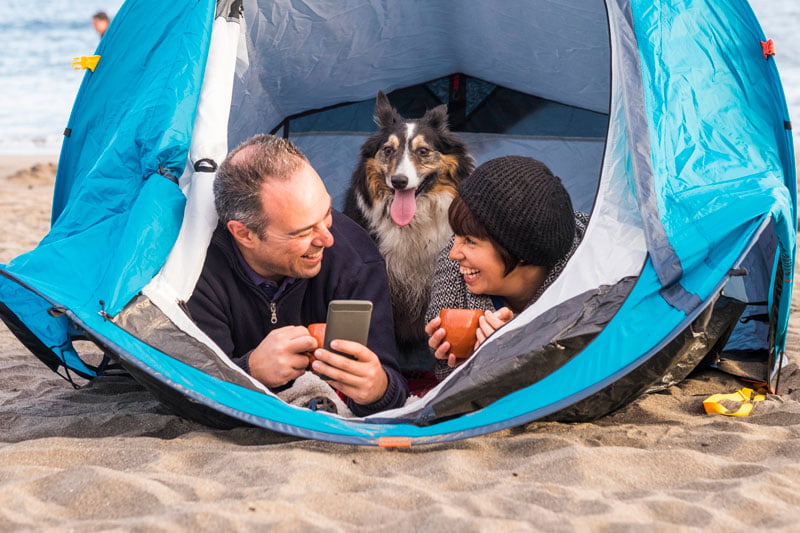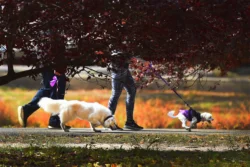Are you ready to take your pup on your first camping trip together? Whether you are a seasoned outdoorsman (or woman) or you are new to this adventure as well, taking a dog along requires additional amounts of planning. If you are not well-prepared, the trip can quickly turn into a nightmare.
With the right preparation and by following a couple quick tips however, the first camping trip with your dog becomes a wonderful experience you will always remember.
1. Get your pup used to new places
If your dog has not had a lot of experience visiting new places, you should get him out and about before heading out for your camping adventure. Perhaps you just adopted a young puppy or a rescue dog who has not yet seen a lot of the world – then you should start small by taking him to different parks, to an outdoor mall or to a new trail nearby. Another great way to get your puppy used to new places and other dogs is to start attending group training sessions for puppies, this way your puppy can learn basic obedience at the same time.
Dogs can be quite apprehensive towards unknown locations if they are not used to visiting different places. You do not want to go camping with a pup who is scared and anxious. The good news is that the more new places you take your dog, the easier he accepts that traveling is just a part of life, and he will enjoy and look forward to your outings.
2. Get heartworm, flea and tick medication
Before you head out, make sure that your dog is on a heartworm preventative and has received flea and tick medicine. Sleeping in a tent and spending a lot of time outside, the chances for getting bitten by a mosquito (which transmit heartworm disease), fleas or ticks are pretty high. Dogs can get very sick and even die from the illnesses these little buggers can give them. While they are more prevalent in warm and wet climates, you should never rely on not encountering them.
Luckily, there are plenty of powerful preventatives available for purchase that will keep your pup safe and healthy. Never skip out on these medications – your dog will thank you!
3. Practice your dog’s recall
The last thing you want is to lose your dog during the camping trip. You need him to come when called everywhere, even with distractions. Many owners make the mistake to believe that because their dog comes when called at home, he will come anywhere. This is not true.
Dogs are so-called “situational learners”. That means that they will associate a learned behavior with the situation they learned it in. If you only practice your dog’s recall in the house, he will come when called at home – but not anywhere else!
In order to generalize your dog’s skills, practice coming when called in as many different outdoor locations as possible: your yard, the park, a hiking trail close to your home etc. Only when you are happy with his recall in a variety of places, you should trust it during your camping trip as well.
4. Pack extra food
Especially if you are headed out for a longer camping trip, you should pack more food than your pup would usually eat. This is because he will likely burn a lot more calories than at home. Running around outside all day consumes much more energy than sitting on the couch. You do not want your pup to go hungry.
Plan to pack at least 25% more food than you would usually feed at home. It is highly advised to take dry food (“kibble”) when camping – it weighs much less and is easier to store than canned or raw food.
5. Take tweezers
It is nearly guaranteed that you will need tweezers at some point during your camping trip with your dog. While these should not be missing in any human first aid kit either, if they are not yet part of your camping equipment, add them now.
The less experienced your dog is outdoors, the higher the chance that he will repeatedly step into prickly plants and get spikes in his feet. They can be surprisingly difficult to remove with your fingers, so make sure to carry a small pair of tweezers in your pocket at all times.
6. Plan sleeping arrangements
Before you head out, make a plan for where your dog is going to sleep. If you have a small breed dog, he can probably just curl up next to your sleeping bag in the tent. With a large dog like a Great Dane or Saint Bernard however, your tent might be too small to accommodate you and your dog.
Some breeds such as Great Pyreneese or Huskies will enjoy sleeping outside under the stars, whereas more fragile dogs such as Greyhounds might need to sleep in your car or their own tent. Do not make sleeping arrangements on the fly – plan ahead to make sure your pup can sleep comfortably.
7. Take back-up equipment
Bring a backup option of everything that you absolutely need for your dog. This includes a second leash, a collar, and a backup water bowl. You do not want to stand in the wilderness without any of those!
An inexpensive option for a backup leash and collar is to bring a slip lead (like those that are used at veterinary clinics). It can work as a leash-collar combination in a pinch and takes up very little space in your backpack. Even with a dog that listens perfectly, you should never go camping without a leash – it will come in handy often!
The bottom line
Camping with your dog is a wonderful adventure. Dogs love to be outdoors and spend time with their humans, and going on a trip together will strengthen your bond and leave both of you wanting more!
Before heading out, you need to plan ahead. Think about sleeping arrangements, make sure your dog has received heartworm and tick medicine, pack everything you need (including more dog food than usual) and practice coming when called in new environments with your dog.
The better prepared you are, the more you will enjoy the camping trip. Of course, don’t forget to bring a camera and take many pictures of your vacation together.






